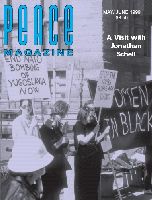
Peace Magazine May-June 1999, page 30. Some rights reserved.
Search for other articles by PMag staff here
Fred H. Knelman Montreal: Black Rose Books,1998. Xii + 224 Pages. Isbn:1-55164-137-2 (Bound); 1-55164-136-4 (Pbk).
This book is concerned with sustainability, social and ecological. Sustainability, as defined by the author, is not the same as sustainable development, which he considers to be an oxymoron. Sustainability "means meeting the real needs of the present with a response that can be sustained into the long-term future."
The book is directed to university students in the arts and humanities or interdisciplinary studies, as well as to all citizens concerned with the impacts of technology on society and the environment and the threat of nuclear war. The author's aim is to provide these individuals with knowledge that will allow them to assess and influence policies related to these topics.
The book begins with a brief history of the development of science from the Greeks until our time, followed by four chapters dealing with the development and dangers of nuclear energy. The author is totally opposed to any use of nuclear energy, even for peaceful purposes, and presents strong arguments in support of his opinion. He goes on to discuss the various efforts that have been made and are still being made to eliminate the risk of nuclear disaster.
The next chapters deal with ecological concerns, and the risks that are posed by globalization. The danger of stratospheric ozone depletion by chlorofluorocarbons is discussed, as well as the partial success that has been achieved in controlling the release of these compounds.
Anyone seeking information on these topics should find this book a convenient source. An index would perhaps have made it easier to use.
The last chapter of the book, entitled "Moving towards sustainability," argues that Canada can become an eco-nationalist state, based on social and environmental sustainability, and goes on to describe how this could be done. The process would require such radical changes in the Constitution and almost all aspects of society that it is inconceivable to me that it could ever be even considered, let alone achieved.
The generally sombre tone of the book is relieved by the inclusion of two chapters of anecdotes and accounts of incidents in the author's life or the lives of others, some of them quite amusing.
Unfortunately there are more errors in this book than I would have expected in a serious work. Some of these are typographical errors that should have been eliminated by proper proof-reading, but others suggest hasty writing or insufficient attention to sources. It is probably excusable to refer to "The Sceptical Chymist" as "The Scyptical Chemist," but surely not to refer to Ethel Rosenberg as "Ethyl." A list of Greek thinkers of the third century B.C. should not contain Pythagoras, Socrates, Ptolemy, and others from earlier or later times. I cannot imagine what "two-and-a-half nuclear wars" can mean. The quotation at the head of chapter 9 is incorrect. It makes no sense to say that synthetic organic compounds do not break down in the environment because of their lack of enzymes. An account of an outbreak of river blindness in an African river after a herd of hippopotamus was shot seems to be completely garbled. All these errors are almost trivial, and do not seriously weaken the argument that the author is making. They do however mar the appearance of the book, and reduce its value because the reader cannot but wonder if there are other errors of greater significance that have gone undetected. This is a pity.
Reviewed by Robert Baxter

Peace Magazine May-June 1999, page 30. Some rights reserved.
Search for other articles by PMag staff here